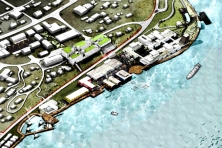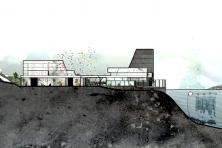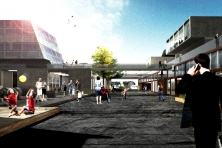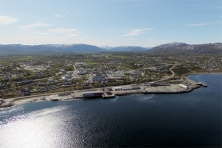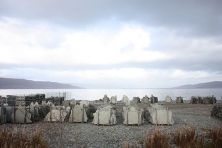Busy Bosse!
Alta (NO) - Special Mention
TEAM DATA
Team Representative: Tin Phan (NO) – urban theorist & architect
Contributor: Wai Fung Chu (HK) – architect, Eakapobh Huangthanapan (TH) – urbanist architect
Gattaca + collaborators, Schweigaardsgate 34C, 0191 Oslo (NO)
+47 450 307 48 - tin@gattaca.no - gattaca.no
See the complete listing of portraits here
See the site page here

T. Phan, W. Fung Chu & E. Huangthanapan
INTERVIEW
Click on the images to enlarge
1. How did you form the team for the competition?
We formed the team quite randomly actually. Our team represents 3 different nationalities and schools. We met during one brief semester at Longyearbyen in Svalbard (NO) while we studied at the Oslo School of Architecture (AHO) some years back. There the three of us got to know each other over cooking Thai curry for the classmates, and it is safe to say we got along and kept in touch after all this time!
2. How do you define the main issue of your project, and how did you answer on this session main topic: the place of productive activities within the city?
We identified the main issue of Alta, and the main topic of productive activities as the one and same thing; productivity brings with it intrinsic social qualities to a given site, relocate and you lose it. With social conditions as the baseline, the challenge was to find a common denominator and a holistic approach for a site with a vast array of multi-faceted issues and potentials. The brief dabbles in everything from tourism, harbor-front development, entrepreneurship, slate industry, to student housing etc. They all had urban, cultural, industrial and social character to them, therefore requiring a holistic, yet critical understanding.
3. How did this issue and the questions raised by the site mutation meet?
By its common denominator – social networks. Although the site required physical structures to maintain the wide array of potentials in multiple industries such as agriculture, technology, tourism etc., we also added a plan to facilitate social structures within the physical ones. If we are to trust research in the field, productive high-tech facilities alone are not enough to cultivate certain innovations or as urban quality. Social and “soft” programming of buildings, encouraging increased tolerance and openness towards ideas and mutual understanding, are equally important as physical manifestations!
4. Have you treated this issue previously? What were the reference projects that inspired yours?
Our references are only but a few, but they were decisive. As we mentioned we all met each other during one brief semester at Longyearbyen in Svalbard (NO) while we were studying at AHO. There, the entire studio tackled every possible aspect of everyday Arctic urbanism. The studio gave us an understanding of the nature of activities in desolate Arctic areas. Wai and Eakapohb already worked together in a student project on harbor-front/tourism infrastructure project in Longyearbyen, another Arctic city. Tin on the other hand, had more literary references on fundamental social and human qualities of entrepreneurship, productive cities and regions throughout the world, mainly Manuel Castells. Here Castells observed the key success of long-term productive cities, was to have functional and operative relations between professionals. Without this, companies either left the area, or was not able to innovate.
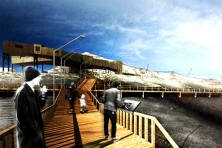
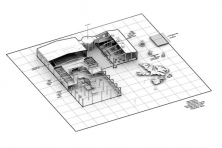
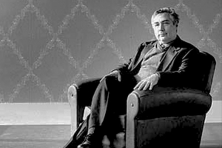
5. Urban-architectural projects like the ones in Europan can only be implemented together with the actors through a negotiated process and in time. How did you consider this issue in your project?
The social and soft programming as mentioned, also focused heavily on the afterlife of buildings as crucial for long-term success of the area. It means that this includes a wide array of actors (like the site’s issues and potentials), such as government officials, coworking and housing administration, shopkeepers, restaurateurs, workshop masters etc. and it was decisive in our proposal and has to work together towards a common goal for the long haul. To somehow start guaranteeing a lasting social dimension to places, us as architects and urbanists can no longer guarantee when we finish any given project.
6. Is it the first time you have been awarded a prize at Europan? How could this help you in your professional career?
Yes, this is both our first Europan award and participation. Even though we only received a special mention, Europan’s reputation and international reach make it easy to promote our work with a quality stamp without any further explanation, for existing and future clients, employers, professors, and professionals.
